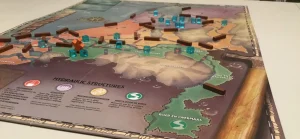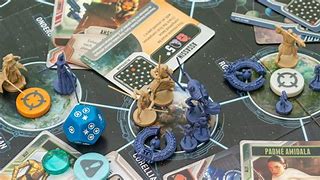Pandemic Rising Tide

It is the dawn of the Industrial Age in the Netherlands. For centuries, the country has relied upon a series of dikes and wind-powered pumps to keep it safe from the constant threat of flooding from the North Sea, but this system is no longer enough. In Pandemic: Rising Tide, it is your goal to avert tragedy by constructing four modern hydraulic structures in strategic locations that will help you defend the country from being reclaimed by the ocean. Storms are brewing and the seas are restless.
It will take all your guile to control the flow of water long enough to usher in the future of the Netherlands. It’s time to get to work. Containing the water that threatens to consume the countryside is your greatest challenge. Water levels in a region are represented by cubes, and as the water containment systems currently in place begin to fail, more water cubes are added to the board. With water levels constantly on the rise, failure to maintain the containment system could quickly lead to water spilling across the board. To successfully build the four hydraulic structures needed to win a game of Pandemic: Rising Tide, you must first learn to predict and manipulate the flow of water. Failing to maintain safe water levels throughout the country can bring you perilously close to failing your mission. Fortunately, water can be corralled by a strategically placed dike or slowed by pumping water out of a region. Correctly identifying and intervening in at-risk areas can get you one step closer to victory.
Rising Tide is set in the Netherlands, with a map of the nation acting as the game board. You work together to prevent flooding in low-lying areas and drain tracts of land for expansion.
Players familiar with other Pandemic games will be completely at ease with the form and gameplay. Each player’s character has a specific ability that needs to be used to the advantage of the team. One player may remove additional water cubes as the pump operator for example. Meanwhile, the hydraulic engineer could build additional dikes on their turn.
The gameplay takes place on the board. Here, characters manage the flooding crisis, but at the same time each player is also managing a hand of cards. One needs to balance the cards in one’s hand to achieve objectives, yet still use the cards wisely to share resources around the team. Water and flooding is symbolised by blue cubes and water can flow between regions depending on the presence (or absence) of man-made dikes, depicted on the board by wooded walls.
Players use up to four actions for their character. These actions allow them to move between regions, remove water, rebuild some of the water-controlling dikes or use some of their cards to achieve the main objectives. Use of the cards also allows players to build pumping stations or ports or to travel between regions. As with Pandemic, there are decisions to be made regarding the need to travel to an area in crisis against removing sufficient water from regions to prevent flooding.
Every turn leads to wear and tear of the normal Dutch water defences. Between two and four regions suffer degradation and the protective dikes are removed. This allows water to ingress to the low-lying regions. These region cards are drawn at random, but as with “standard” Pandemic, when a storm falls one region will suffer severe damage and the earlier region cards are shuffled to be reused again. This leads to great tension in ensuring that everything has been done by the player during their action to mitigate against disaster, but inevitably there is some element of chance that means that even the most prepared will suffer unexpected loss.
Each player’s turn finishes with water flowing between regions across regional boundaries and into low-lying areas that have not been adequately protected by dikes. This might lead to a chain reaction of sequential flooding in several areas and if all of the water cubes are used before completion of the objectives, the game is lost.
After several games where I was aiming to achieve the building of the four structures, I decided to graduate to the alternative objectives. These make Rising Tide a much more fiendish puzzle and battle of wits against the elements. As a result, the game moves to a different level. Contained within the basic game is an expansion of extra alternative objectives and additional gameplay involving the Dutch population (represented by red cubes). This is where decisions are crucial, and this really makes the game more re-playable and challenging.
Depending on which objectives are drawn, players need to develop the regions with populations by discarding region cards. By needing to use cards within one’s hand to increase a population, this can make completion of other objectives more difficult. As flooding occurs across the regions, the increase in water levels will affect the populations already there. This can mean some populations will die.
Another challenge is to ensure that no more than four populations are lost. The loss of five means that the game is over, irrespective of whether the objectives have been achieved. Some of the new objectives bring a level of intensity to the game and mean the Netherland’s flood defences start in a poorer state. As confidence and experience grows players can increase the difficulty of the game by increasing the numbers of objectives to be fulfilled, as well as increasing the frequency and number of storm cards within the deck.
CLick here for a review of Rising Tide then here to find out more abou the game on Amazon and to add to your growing Pandemic collection. We found it to be a great Pandemic style game.





